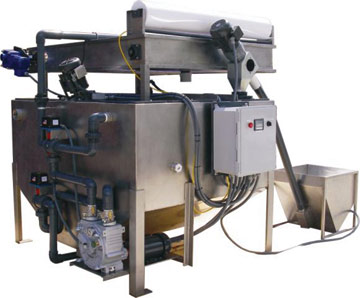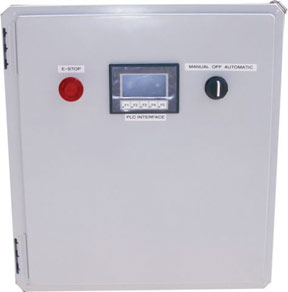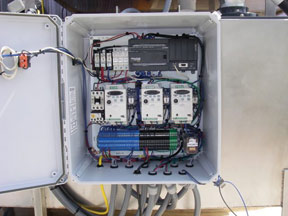Treating waste water generated in industrial plants requires an efficient, easy-to-use process which yields minimal by-product; it must be reliable and durable too. Environmental Compliance Equipment, in Palm City, Florida, designs systems to meet these requirements. One such system is marketed as ClearFlow.
The ClearFlow System Explained

ClearFlow systems can be integrated in almost any facility that generates waste water in the process of providing a product to consumers. For example, when the ink was washed from the lithograph printing press used to print this magazine, an ink/water waste resulted. The ClearFlow system can treat the water, making it clean enough to be discharged; remaining solids become non-hazardous material.
The automation side of the ClearFlow system allows operators variable functionality, quick and easy access, and reliability. By choosing AutomationDirect products, Environmental Compliance Equipment acquired the tools needed to meet the goal.
The ClearFlow system processes waste water in a batch cycle; one volume of waste water is completed before repeating the process. The number of batches is measured hourly so the value of this process – and machine – lies in its efficiency to treat many batches each hour.
 Because each waste stream may vary, the DL06 PLC was selected for its versatility and ability to adapt to each client’s needs. The DL06 also provides the ability to add expansion modules to take on such challenges as pH control, temperature monitoring, Total Dissolved Solids (TDS), and Total Suspended Solids (TSS), all of which require discrete I/O interfaces from separate controllers.
Because each waste stream may vary, the DL06 PLC was selected for its versatility and ability to adapt to each client’s needs. The DL06 also provides the ability to add expansion modules to take on such challenges as pH control, temperature monitoring, Total Dissolved Solids (TDS), and Total Suspended Solids (TSS), all of which require discrete I/O interfaces from separate controllers.
• Fill the system with waste water and mix; adjust pH if required. Versatility of the DL06 allows the system to be incorporated into the plants’ internal control system for monitoring output, alarms and general function of the system.
As mentioned earlier, the batch has to be treated quickly and efficiently. During each batch, the system performs sequential tasks to treat the waste water.
The tasks are as follows:
• Separate solids from the waste water by adding a special Clayfloc flocculent and allow separated (flocced) solids to settle.
• Next, pump the combined mixture to a filter to separate solids from clean water. Monitor TDS or TSS if required.
• When the filter becomes clogged or unable to pass water, it is indexed forward to supply clean filter paper.
• Once complete, the system is emptied and another batch begins.

Each step is controlled using a timer or speed measurements, or a combination of both. Using the DL06 PLC with GS1 and GS2 A/C drives provides flexibility in performing these tasks. This allows the system to be efficient enough to use only the amount of consumables necessary to treat the waste water, generate as little byproduct as possible, and reduce operating costs.
Employing the C-more Micro touch screen panels provides ease of use and accessibility, which meets another design criterion. The C-more Micro gives operators access to all facets of system operation.
The HMI allows operators to manipulate each sequence timer in the DL06, optimizing the system for maximum throughput, while also providing information about the system’s
conditions, alarm indicators (when consumables are exhausted), and if/when the system has been disabled. Another important feature of this interface is that it allows manual operation of each function using the touchscreen.
The reliability and low cost of the AutomationDirect products were major factors in choosing them for the ClearFlow treatment system.
View products from AutomationDirect that relate to this article: DL06 PLCs ׀ C-more Micro Panels ׀ AC Drives
By Andrew C Hyatt
Environmental Compliance Equipment
Originally Published: Sept. 1, 2008

